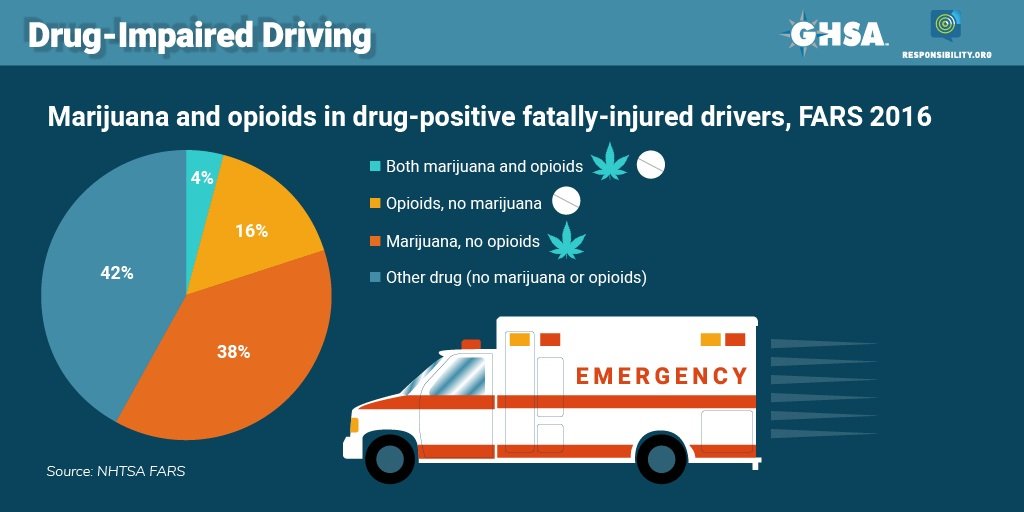 A 2018 Governors Highway Safety Association study, Drug-Impaired Driving: Marijuana and Opioids Raise Critical Issues for States, found that, in 2016, 44% of fatally injured drivers with known results tested positive for drugs, up from 28% just 10 years prior. More than half of these drivers had marijuana, opioids or a combination of the two in their system.
The best way to reduce drugged driving, according to Mothers Against Drunk Driving (MADD), is the use of standardized field sobriety testing (SFST), the foundation of impaired driving detection and enforcement for 800,000 law enforcement officials across the country. Some states, however, do not require SFST training for officers assigned to patrol functions.
As MADD says: Myths and misinformation are part of the problem. Get the facts—and share them with your loved ones, especially young adults. Why? More than one-third of teens mistakenly believe they drive better under the influence of marijuana.
The 2019 Cars and Cannabis survey was conducted online using Survey Monkey. One thousand and sixty-three participants were polled, spanning the U.S., with the U.S. driving population represented by the 997 respondents who, before completing the survey, answered that they have a driver’s license. The demographics of those polled represented a broad range of household income, geographic location, age and gender.
This article was originally published on DriversEd.com.
A 2018 Governors Highway Safety Association study, Drug-Impaired Driving: Marijuana and Opioids Raise Critical Issues for States, found that, in 2016, 44% of fatally injured drivers with known results tested positive for drugs, up from 28% just 10 years prior. More than half of these drivers had marijuana, opioids or a combination of the two in their system.
The best way to reduce drugged driving, according to Mothers Against Drunk Driving (MADD), is the use of standardized field sobriety testing (SFST), the foundation of impaired driving detection and enforcement for 800,000 law enforcement officials across the country. Some states, however, do not require SFST training for officers assigned to patrol functions.
As MADD says: Myths and misinformation are part of the problem. Get the facts—and share them with your loved ones, especially young adults. Why? More than one-third of teens mistakenly believe they drive better under the influence of marijuana.
The 2019 Cars and Cannabis survey was conducted online using Survey Monkey. One thousand and sixty-three participants were polled, spanning the U.S., with the U.S. driving population represented by the 997 respondents who, before completing the survey, answered that they have a driver’s license. The demographics of those polled represented a broad range of household income, geographic location, age and gender.
This article was originally published on DriversEd.com.Drugged Driving Kills; Why Can't We Stop?
While Americans know that driving after smoking or ingesting marijuana is dangerous, one-fourth of them admit to doing so.

 A 2018 Governors Highway Safety Association study, Drug-Impaired Driving: Marijuana and Opioids Raise Critical Issues for States, found that, in 2016, 44% of fatally injured drivers with known results tested positive for drugs, up from 28% just 10 years prior. More than half of these drivers had marijuana, opioids or a combination of the two in their system.
The best way to reduce drugged driving, according to Mothers Against Drunk Driving (MADD), is the use of standardized field sobriety testing (SFST), the foundation of impaired driving detection and enforcement for 800,000 law enforcement officials across the country. Some states, however, do not require SFST training for officers assigned to patrol functions.
As MADD says: Myths and misinformation are part of the problem. Get the facts—and share them with your loved ones, especially young adults. Why? More than one-third of teens mistakenly believe they drive better under the influence of marijuana.
The 2019 Cars and Cannabis survey was conducted online using Survey Monkey. One thousand and sixty-three participants were polled, spanning the U.S., with the U.S. driving population represented by the 997 respondents who, before completing the survey, answered that they have a driver’s license. The demographics of those polled represented a broad range of household income, geographic location, age and gender.
This article was originally published on DriversEd.com.
A 2018 Governors Highway Safety Association study, Drug-Impaired Driving: Marijuana and Opioids Raise Critical Issues for States, found that, in 2016, 44% of fatally injured drivers with known results tested positive for drugs, up from 28% just 10 years prior. More than half of these drivers had marijuana, opioids or a combination of the two in their system.
The best way to reduce drugged driving, according to Mothers Against Drunk Driving (MADD), is the use of standardized field sobriety testing (SFST), the foundation of impaired driving detection and enforcement for 800,000 law enforcement officials across the country. Some states, however, do not require SFST training for officers assigned to patrol functions.
As MADD says: Myths and misinformation are part of the problem. Get the facts—and share them with your loved ones, especially young adults. Why? More than one-third of teens mistakenly believe they drive better under the influence of marijuana.
The 2019 Cars and Cannabis survey was conducted online using Survey Monkey. One thousand and sixty-three participants were polled, spanning the U.S., with the U.S. driving population represented by the 997 respondents who, before completing the survey, answered that they have a driver’s license. The demographics of those polled represented a broad range of household income, geographic location, age and gender.
This article was originally published on DriversEd.com.





